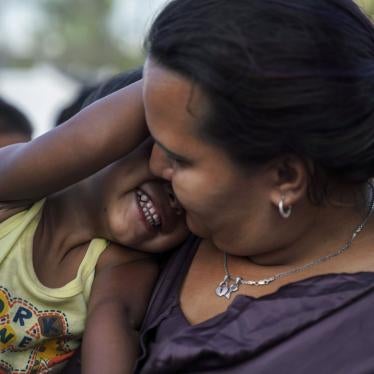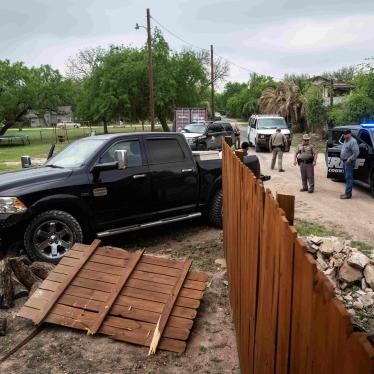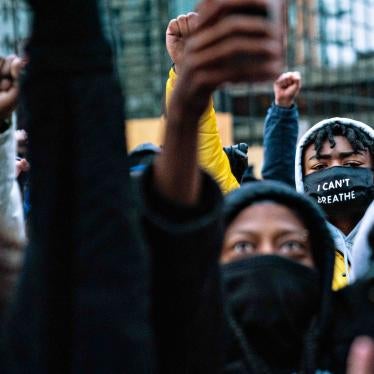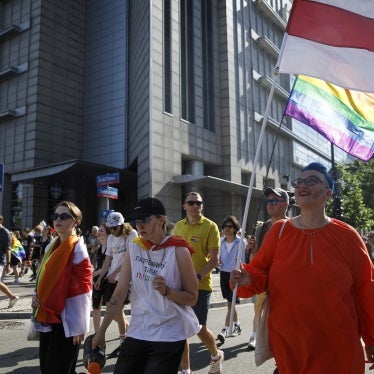Submitted via regulations.gov
Kyle McGowan
Office of the Chief of Staff
Centers for Disease Control and Prevention
1600 Clifton Road NE, MS H21-10
Atlanta, GA 30329
Re: CDC Docket No. CDC-2020-0033, RIN: 0920-AA76, Comments in Response to Interim Final Rule Control of Communicable Diseases; Foreign Quarantine: Suspension of Introduction of Persons into the United States from Designated Foreign Countries or Places for Public Health Purposes
Dear Mr. McGowan,
Human Rights Watch writes to express strong opposition to the Centers for Disease Control and Prevention (“CDC”) Interim Final Rule (“Rule”), published in the Federal Register on March 24, 2020. The Rule is the basis for the CDC’s Order dated March 20, 2020, “Suspending the Introduction of Certain Persons from Countries Where a Communicable Disease Exists” (“CDC Order”).[1] Both the Rule and the CDC Order fail to address US obligations to asylum seekers and unaccompanied migrant children, who are also often asylum seekers, under US and international law. As a result, US Customs and Border Protection (“CBP”) is now expelling unauthorized migrants, including children, without considering whether they are eligible for protection under US law. The Rule, ostensibly intended to protect human life, is instead putting asylum seekers’ lives at serious risk. We urge that the rule be withdrawn in its entirety.
Human Rights Watch is a nonprofit, nongovernmental human rights organization. We operate in 90 countries and have been investigating, documenting, and exposing human rights abuses around the world for four decades. We have published numerous reports on abuses within the US immigration system, including US government failure to meet its obligations to asylum seekers and child migrants under US and international law.
The Rule and CDC Order Fail to Consider US Obligations to Asylum Seekers and Unaccompanied Children
Under US law and the 1967 Protocol Relating to the Status of Refugees, to which the United States is party, the United States may not return asylum seekers to face threats to their lives or freedom without: (1) affording them an opportunity to apply for asylum or for protection against facing the threat of torture; and (2) conducting a full and fair examination of those claims. Even in times of emergency, governments remain obliged to protect refugees from return to a threat of persecution, exposure to torture or inhuman and degrading conditions, or threats to life and physical security.[2] Travel by refugees fleeing threats to their life and safety constitutes essential travel, as it can mean the difference between life or death.[3]
The United Nations refugee agency, UNHCR, released guidance on March 16, 2020 calling for border measures relating to COVID-19 to be necessary, proportionate, and reasonable to the aim of protecting public health. Any “blanket measure” to preclude the admission of refugees and asylum seekers would not meet this standard, according to UNHCR.[4]
The Rule, in serving as the basis for the CDC Order, allows for such inappropriate “blanket measures.” Under the CDC Order, the United States is failing to provide asylum seekers with legal protections designed to ensure they are not returned to a threat of persecution. Also, based on the CDC order, the Department of Homeland Security has issued an Order (“DHS Order”) authorizing CBP agents to “expeditiously expel” to Mexico or to their country of origin migrants encountered between ports of entry, including unaccompanied children.[5]
Summary expulsions pursuant to the Rule also deprive unaccompanied children of important safeguards against human trafficking. The William Wilberforce Trafficking Victims Protection Reauthorization Act of 2008, passed with strong bipartisan support and signed by President George W. Bush, requires specialized screening of unaccompanied children and their expeditious transfer to appropriate care.[6] Without these critical protections, children run the risk of serious harm. Already, since the Order went into effect, CBP has expelled thousands of migrants, including hundreds of unaccompanied children, depriving them of their rights.
Human Rights Watch has previously witnessed and documented CBP agents performing illegal “turnbacks” of migrants exercising their right to seek asylum, including unaccompanied children.[7] Human Rights Watch has also found agents have failed to refer for interviews with asylum officers people who have expressed a fear of return to their country of origin, and instead, rapidly deported them to potential danger.[8] Giving CBP agents even greater power to unilaterally and summarily decide claims under the travel restrictions will very likely risk further wrongful return of people who may be refugees. To cite just one example of the serious consequences that can ensue from such “expeditious” expulsions, Human Rights Watch reported some 200 cases of people killed, raped, or otherwise abused since 2013 after the United States returned them to El Salvador.[9]
The Rule and CDC Order Fundamentally Disregard Risks Faced by Asylum Seekers and the Asylum Process
The CDC order, issued pursuant to the Rule, is based on: insufficient and incorrect information provided by the DHS to the CDC regarding the categories of non-citizens (or “aliens” as the term is used in the Orders) who have a lawful reason to enter in the United States; incorrect information provided by DHS to the CDC regarding the opportunities for release of asylum seekers to families and communities of support inside the United States; lack of information provided by DHS to the CDC about DHS’ discretion to release asylum seekers from custody after appropriate periods of quarantine and under appropriate conditions of supervision; and lack of information provided by DHS to the CDC about the enduring US obligations to asylum seekers under US and international law, even during an emergency.
The CDC Order states that it applies to “covered aliens,” a definition the CDC adopted after receiving information from DHS (the CDC Order states “DHS has informed CDC . . .”). DHS apparently informed CDC that the noncitizens who are traveling from Canada or Mexico who must be held in Ports of Entry or Border Patrol stations are people, according to the CDC Order, “who do not have proper travel documents…whose entry is otherwise contrary to law…and who are apprehended near the border seeking to unlawfully enter the United States.” This definition includes a wide range of noncitizens and fails to specifically address the subcategory of noncitizens who may apply for asylum under 8 USC Sec. 1158, which states, “Any alien who is physically present in the United States or who arrives in the United States (whether or not at a designated port of arrival and including an alien who is brought to the United States after having been interdicted in international or United States waters), irrespective of such alien’s status, may apply for asylum.” The definition also fails to acknowledge CBP’s obligation, as a part of implementing this section of US law, under 8 C.F.R. 235.3(b)(4), to register any claims of fear expressed by a non-citizen and refer them to a credible fear interview.
The CDC’s determination that “covered aliens” should not be allowed entry to the United States is based on information provided by DHS that “many of the aliens covered by this order may lack homes or other places where they can self-isolate,” as stated in the Order, as well as detailed concerns regarding the presence of COVID-19 in Canada and Mexico; and the inadvisability of holding covered aliens in Ports of Entry or Border Patrol stations where medical care is limited and mandated social distancing and related public health precautions will be difficult to achieve. We do not dispute the lack of medical care at Border Patrol stations and the crowded conditions in which migrants and asylum seekers are often held for lengthy periods of time. However, the CDC may not be aware of research completed in 2019 by the US Immigration Policy Center, finding that 91.9 percent of asylum seekers have family or close friends in the United States.[10] That means that many of them could likely be released to those friends and family members after a period of quarantine or other measures as necessary for public health and with appropriate safeguards to ensure their appearance for asylum proceedings. These findings are in keeping with our own extensive interviews with asylum seekers at the US-Mexico border in recent years.
The CDC may also be unaware that CBP is not required to hold migrants and asylum seekers in border detention facilities for long periods of time in crowded, unhygienic conditions. Indeed, CBP’s own standards suggest that adult noncitizens should not be held in these facilities for more than 72 hours. Most unaccompanied children must by law be transferred within 72 hours (though that limit is often ignored). Whether to release migrants and asylum seekers is a matter of discretion, and CBP has the authority to directly and swiftly release such persons, including after a period of quarantine and under possible conditions of supervision, if appropriate.
The Rule and CDC Order Are Based on Unjustified Public Health Claims
The Rule and the CDC Order issued pursuant to the Rule argue that suspension of entry of certain foreigners is necessary for public health reasons. In the CDC Order, the CDC states, “It is necessary for the public health to immediately suspend the introduction of covered aliens” and “the introduction into POEs [points of entry] and Border Patrol stations of covered aliens increases the seriousness of the danger to the point of requiring temporary suspension of the introduction of covered aliens.”
The United States currently has more confirmed coronavirus cases than any other country in the world.[11] Community transmission is already widespread throughout the United States, and all US states have imposed some degree of restrictions on movements to slow transmission.[12] Given these facts, the extraordinary step of barring asylum seekers is not strictly necessary nor will it effectively reduce the burden of COVID-19 that already exists in the US and will continue to exist regardless of this measure.[13] Rational, evidence-based quarantine measures are not in conflict with the right to seek asylum and could be implemented without pushing asylum seekers back to face threats to their lives.
We understand and appreciate the seriousness of the situation that CDC is engaged in addressing, and that rational, evidence-based public health measures are warranted given the threat posed by the COVID-19 pandemic. However, returning refugees to persecution or other grave threats constitutes a serious human rights violation that is not permitted under international law even in times of emergency. And in light of the information we have shared above, we believe you can protect the health of immigrants and the public at large without overbroad new regulations that turn away asylum seekers.
Thank you for the opportunity to submit comments on the rule. Please do not hesitate to contact Grace Meng, senior US researcher at Human Rights Watch, at mengg@hrw.org or at (323) 694-5181 if you have any questions.
Sincerely yours,
Alison Leal Parker
Managing Director
[1] US Health and Human Services, Centers for Disease Control and Prevention (CDC), “Order Under Sections 362 and 365 of the Public Health Service Act (42 USC §§ 265, 268): Order Suspending Introduction of Certain Persons From Countries Where a Communicable Disease Exists,” https://www.cdc.gov/quarantine/pdf/CDC-Order-Prohibiting-Introduction-of-Persons_Final_3-20-20_3-p.pdf (accessed April 22, 2020).
[2] UN High Commissioner for Refugees, “Advisory Opinion on the Extraterritorial Application of Non-Refoulement Obligations Under the 1951 Convention relating to the Status of Refugees and its 1967 Protocol,” https://www.unhcr.org/4d9486929.pdf (accessed April 22, 2020).
[3] Bill Frelick (Human Rights Watch), "Essentail travel in a time of pandemic" commentary, The Hill, April 11, 2020, https://www.hrw.org/news/2020/04/13/essential-travel-time-pandemic.
[4] UN High Commissioner for Refugees, “Key Legal Considerations on access to territory for persons in need of international protection in the context of the COVID-19 response,” March 16, 2020, https://www.refworld.org/docid/5e7132834.html (accessed April 22, 2020).
[5] US Department of Homeland Security, US Customs and Border Protection, 19 CFR Chapter 1, “Notification of Temporary Travel Restrictions Applicable to Land Ports of Entry and Ferries Service Between the United States and Mexico,” https://s3.amazonaws.com/public-inspection.federalregister.gov/2020-06253.pdf (accessed April 22, 2020); Tweet by USBP Chief Patrol Agent, El Centro Sector, March 25, 2020, https://twitter.com/USBPChiefELC/status/1242881223111790592 (accessed April 22, 2020).
[6] Pub. L. No. 110-457, 112 Stat. 5044, Section 235 “Enhancing Efforts to Combat the Trafficking of Children” (2008).
[7] “US: Mexican Asylum Seekers Ordered to Wait,” Human Rights Watch news release, December 23, 2019, https://www.hrw.org/news/2019/12/23/us-mexican-asylum-seekers-ordered-wait; “US: Unaccompanied Children Turned Back at Border, Face Risk of Return to Harm,” Human Rights Watch news release, December 24, 2018, https://www.hrw.org/news/2018/12/24/us-unaccompanied-children-turned-back-border.
[8] Michael Garcia Bochenek, “US Turning Away Asylum Seekers at Mexican Border: Central Americans Who Flee for Their Lives Denied Entry by US Border Guards,” Human Rights Dispatch, May 3, 2017, https://www.hrw.org/news/2017/05/03/us-turning-away-asylum-seekers-mexican-border; Human Rights Watch, You Don’t Have Rights Here: US Border Screenings and Returns of Central Americans to Risk of Serious Harm, October 16, 2014, https://www.hrw.org/report/2014/10/16/you-dont-have-rights-here/us-border-screening-and-returns-central-americans-risk.
[9] Human Rights Watch, Deported to Danger: US Deportation Policies Expose Salvadorans to Death and Abuse, February 5, 2020, https://www.hrw.org/news/2020/02/05/us-deported-salvadorans-abused-killed.
[10] Tom K. Wong, US Immigration Policy Center, University of California San Diego, “Seeking Asylum: Part 2,” October 29, 2019, https://usipc.ucsd.edu/publications/usipc-seeking-asylum-part-2-final.pdf (accessed April 22, 2020).
[11] Pablo Gutierrez, “Coronavirus map: which countries have the most cases and deaths?”, Guardian, April 23, 2020, https://www.theguardian.com/world/2020/apr/21/coronavirus-map-which-countries-have-the-most-cases-and-deaths-covid-19 (accessed April 22, 2020).
[12] Centers for Disease Control and Prevention, “Cases of Coronavirus (COVID-19) in the U.S,” https://www.cdc.gov/coronavirus/2019-ncov/cases-updates/cases-in-us.html (accessed April 22, 2020); Kaiser Family Foundation, “State Data and Policy Actions to Address Coronavirus,” April 22, 2020, https://www.kff.org/health-costs/issue-brief/state-data-and-policy-actions-to-address-coronavirus/#socialdistancing (accessed April 22, 2020).
[13] Joanna Naples-Mitchell, “There is No Public Health Rationale for a Categorical Ban on Asylum Seekers, “ Just Security, April 17, 2020, https://www.justsecurity.org/69747/there-is-no-public-health-rationale-for-a-categorical-ban-on-asylum-seekers/ (accessed April 22, 2020).






